Gretsch: Early History; Archtops from Electromatic to Double Anniversary
Friedrich Gretsch (1856-1895) was a German émigré to the USA who set up a New York-based company making banjos and percussion instruments in 1883. Following his sudden death fifteen years later, the firm was taken over by his teenage son, who eventually came to be known as Fred Gretsch, Snr. Under Fred Snr.'s management, Gretsch expanded, and began manufacturing acoustic archtop and flat-top guitars in the 1930s. Its first electric archtop, the 'Electromatic Spanish,' was launched in 1940, but no examples or precise information about it survive, although its body was 17 inches (43.2cm) wide. Nine years later (with Fred's son, Fred Gretsch, Jnr, now at the helm), a higher-profile, slightly smaller single pickup instrument bearing the same name was introduced. In 1951 came the Electro II - offered in cutaway 17-inch (43.2cm) and non-cutaway 16-inch (40.6cm) versions - and the 16-inch Electromatic, which was available with one or two pickups. In 1954, the Electromatic was renamed the Streamliner, while the cutaway Electro II became the Country Club.
Gretsch electrics frequently featured striking finishes and elaborate gadgetry. The company's bold, even florid approach to design was apparent on the top-of-the-line White Falcon, which made its debut in 1955. An unashamedly ostentatious guitar, with a retail price of $600, it boasted gold sparkle decoration, gold-plated metalwork, and bird and feather engravings on its pickguard and fingerboard position markers. Later versions incorporated stereo circuitry and an ingenious mechanical string mute mounted between the back pickup and the bridge (see photo).
Gretsch guitars were especially popular with country musicians and rockers, including Chet Atkins (see next section), Hank Garland, Duane Eddy, and Eddie Cochran. The company also had a following among jazzmen; its 1959 floating-pickup Convertible electric/acoustic was endorsed by Sal Salvador (1928-1999), former guitarist with the Stan Kenton Big Band. The year before the Convertible came out, Gretsch had celebrated 75 years of instrument making by unveiling a pair of electric archtops, the Anniversary (single pickup) and twin-pickup Double Anniversary. These models were fitted with the company's "Filter-'Tron" humbuckers (previous Gretsch electrics had sported single-coil transducers manufactured by DeArmond), and, at under $200 each, were comparatively inexpensive guitars, "priced for promotional selling," as the company's publicity put it. They remain desirable collectors' items.
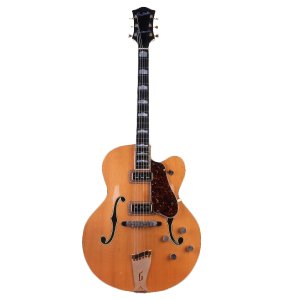
GRETSCH ELECTRIC ARCHTOP, 1953
This instrument is particularly unusual because it has four control knobs grouped together on its lower treble bout. Gretsch electrics normally have two or three rotary controls there, and another (the master volume) near the cutaway. Confusingly, the 'Synchromatic' legend on the guitar's headstock also appears on some Gretsch acoustics.
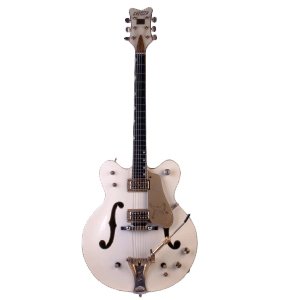
GRETSCH WHITE FALCON, 1966
The original White Falcon, launched in 1955, had a single cutaway; this double-cutaway version appeared in the early 1960s. It boasts two "Filter-'Tron" pickups, and its string mutes (the two black pads just above the bridge) are controlled by twin lever switches on either side of the tailpiece.
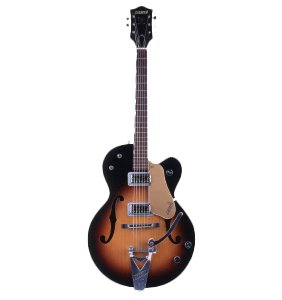
GRETSCH DOUBLE ANNIVERSARY, 1961
This instrument, made three years after the first Double Anniversaries, is fitted with single-coil "Hi-Lo'Tron" pickups instead of the original "Filter'Tron" humbuckers. It has a master volume control, individual volume knobs for each pickup, and two switches – one to select and combine the pickups, the other to provide different tone settings.
Gretsch And Chet Atkins
In 1954, Gretsch signed an endorsement deal with prominent Nashville guitarist Chet Atkins (1924-2001) - a move that raised the company's profile and contributed significantly to its success. Atkins, famous for his session and solo work, was also assistant to the Head of RCA Records in Nashville, and his career was to reach new heights in 1957, when he was made Chief of RCA's Country Division. However, by the mid-1950s, he had already played on, arranged, and produced a string of hit records, and was helping to shape what came to be known as the Nashville Sound.
The earliest versions of the Gretsch Chet Atkins guitar, the 6120, were not entirely to its endorsee's liking. He commented of the pickups' lack of sustain, and also had reservations about the 'longhorn' headstock logo and 'Western' fret markers on the first 6120s (these features were subsequently phased out). However, he soon started using the new model for recordings and live work, and is quoted as being "thrilled" at the introduction of a guitar bearing his signature. Gretsch was equally delighted to have him on board, and in 1957, a second Chet Atkins guitar, the Country Gentleman, was launched. It looked like a normally constructed archtop, but had no soundholes; Atkins and Gretsch had found that sealing the instrument helped to minimise acoustic feedback, and 'pseudo-f-holes' were painted onto its top in order to create a trompe l'oeil effect.
The Country Gentleman was followed a year later by a lower-price design, the Tennessean, which was originally fitted with a single pickup. All three instruments remained in production until the 1980s. Later that decade, Gibson began making versions of various Atkins-approved models (see Gibson article), but the Atkins family signed a fresh endorsement deal with Gretsch in 2007 (six years after Chet's death), leading to the appearance of more Gretsch/Atkins guitars.

GRETSCH CHET ATKINS HOLLOW BODY (MODEL 6120), 1959
This guitar's 16-inch (40.6cm) top is made from laminated spruce; its back and sides are laminated maple, and the neck is mahogany. It has a humbucking pickup; earlier models featured a P-90 single-coil unit. The one-pickup version of the ES-175 was discontinued in 1972.
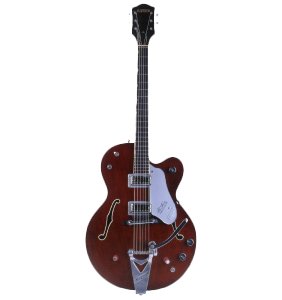
GRETSCH CHET ATKINS TENNESSEAN, 1963
The first version of the Tennessean, which appeared in 1958, had just one humbucker, but in the early 1960s two single-coil pickups were substituted. Like all the Chet Atkins models seen here, this guitar is fitted with a Bigsby vibrato “ Atkins' favoured unit - carrying the Gretsch name.

GRETSCH CHET ATKINS COUNTRY GENTLEMAN, 1965
The Country Gentleman has a 17-inch (43.2cm) body (an inch wider than the 6120). On this example, the pickguard lacks the Chet Atkins signature that appears on the other two guitars, though the model name is shown on the metal plate screwed to the headstock. Note the fake f-holes!
Gretsch Solid-bodies
At first, Fred Gretsch, Jnr. had been sceptical to the point of derision about solid-body instruments, expressing his horror to Gibson President Ted McCarty over that company's introduction of the Les Paul in 1952 by commenting that "now anyone with a band saw can make a guitar." Nevertheless, just a year later Gretsch launched its own electric solid-body, the Duo-Jet. It had some similarities to the Les Paul, but was differently constructed (see caption), and, like other Gretsch electrics of the period, was fitted with pickups made by DeArmond, which had made its early reputation with 'floating' transducers designed for acoustic archtops. The Duo-Jet went through a number of modifications, eventually acquiring a double cutaway and a pair of Gretsch's own humbucking "Filter-'Tron" pickups. The firm also made several other closely related 'Jet' models, including the Jet Fire Bird, which first appeared in 1955.
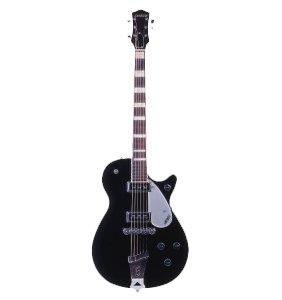
GRETSCH DUO-JET, 1956
Unlike the Gibson Les Paul, which has a similar shape, the Duo-Jet is not completely solid; there is substantial routing inside its mahogany body. The model is associated with several famous players, notably George Harrison, who often used one with The Beatles.

GRETSCH JET FIRE BIRD, 1965
This 1960s version of the Jet Fire Bird has a double cutaway and two Gretsch "Filter-'Tron" pickups. It retains the internal body routing found on the original Duo-Jet. The 'thumbprint' position markers on its neck are a characteristic Gretsch feature, also found on many of the firm's archtop electrics.
Footnote: Gretsch Today
Fred Gretsch, Jnr. sold his family's business to the Baldwin Piano Company on his retirement in 1967, and the 1970s proved to be a difficult period for Gretsch, production of whose guitars and drums was ended by Baldwin in 1980. However, the firm has since been acquired by descendants of its founders; it began making instruments again during the mid-1980s, and its manufacturing and distribution are now handled by Fender. Gretsch celebrated its 125th anniversary in 2008.